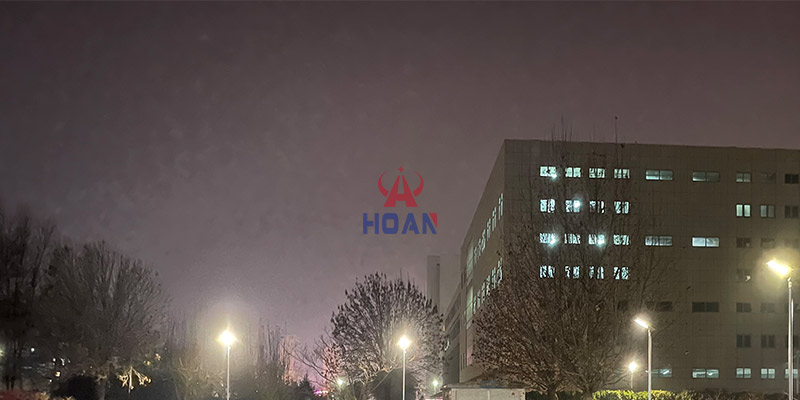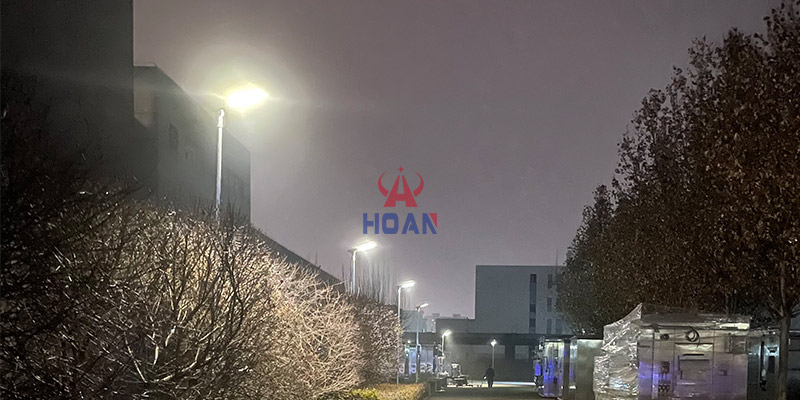Strolling through the city at night, the yellow street light glow is almost everywhere, forming a warm halo. From the main road to the alley, yellow street lights seem to have become the iconic elements of the city night scene. But have you ever wondered why city streetlights are mostly yellow? Behind this phenomenon, it is not an accidental choice, but the result of a combination of optical principles, human visual characteristics, historical technological development and cost-effectiveness. In this paper, we will analyse the reasons for this, and explore solar street lights for urban lighting to bring innovative changes for urban lighting planners, designers and ordinary readers to unveil the mystery of urban lighting.
The principle of wavelength of light
The wavelength of light determines its propagation characteristics in the air. Yellow light has a wavelength range of about 570 - 590 nanometres, which belongs to the long-wave region of visible light. Compared to shorter wavelengths such as blue (approx. 450 - 480 nm) and violet (approx. 380 - 450 nm), yellow light is less likely to scatter when it interacts with airborne particles during propagation. This means that yellow light is able to travel in a more concentrated manner with less energy loss.
Adaptability to severe weather
The advantages of yellow light are particularly obvious in weather conditions with low visibility, such as rain, fog and dust. For example, in foggy weather, short wavelength light is easily scattered by fog particles, resulting in light dispersion and weakened lighting effect. The yellow light, with its long wavelength characteristics, can penetrate the fog, spread a longer distance, and still remain clearly visible, effectively guaranteeing road safety.
Principle of human eye light sensitivity
Cone cells and rod cells in the retina of the human eye have different light-sensing functions. Cone cells are mainly responsible for bright vision and colour perception, while rod cells play a role in low-light environments. Research has shown that optic rod cells are more sensitive to yellow light. When yellow light enters the eye, it does not irritate the retina as much as short-wavelength light, and is less likely to produce a blinding glare effect.
Night Driving Safety
For drivers driving at night, the lighting environment created by yellow street lights is crucial. The low-glare nature of yellow light significantly reduces visual fatigue. Under such light, drivers can more clearly distinguish road contours, pedestrian dynamics and obstacles, so as to react in a timely manner, reducing the probability of traffic accidents.
Optic cone cells and optic rod cells
There is a clear division of labour between optic cone cells and optic rod cells. At night or in a dimly lit environment, the optic rod cells become dominant. The wavelength of yellow light happens to be in the more sensitive zone of the optic rod cells, which makes the human eye better able to perceive the light and darkness of the surrounding environment under yellow light illumination, and improves visual clarity.
Advantage of Dark Vision Conversion
When the human eye enters a dark environment from a bright environment, there is a process of visual adaptation, i.e. dark adaptation. Research has found that the human eye adapts faster to yellow light during the dark adaptation process. This means that pedestrians or drivers can recover their visual functions faster under yellow street lights, reducing safety risks caused by visual holdover or delayed adaptation.
Colour contrast effect
Yellow light provides a good contrast to the colours of common objects in the urban environment. Roads are mostly grey or black, and vehicles and pedestrians dress in a variety of colours, but yellow light as a background light can make the outlines and details of these objects stand out. For example, red traffic signs and white road markings are more clearly recognisable under yellow street lights.
Warning and psychological impact
From the perspective of human cognition, the colour yellow has natural warning properties. In nature, many dangerous organisms or toxic substances are marked with yellow, and this cognitive habit extends to urban lighting. Yellow street lights can subconsciously remind people to pay attention to the surrounding environment, enhance safety awareness, and play a certain role in warning.

The development of high-pressure sodium lamps
Reviewing the history of urban lighting, the emergence of high-pressure sodium lamps has a milestone. Since the middle of the 20th century, high pressure sodium lamps have rapidly become the mainstream choice for urban street lighting due to their high luminous efficiency (up to 150lm/W), relatively low cost and long service life (up to 20,000 - 24,000 hours). The colour of light emitted by high pressure sodium lamps is close to the yellowish orange, which has laid the foundation for yellow street lamps in urban lighting.
Technical continuity
The city lighting system is huge in scale, and the replacement of streetlights requires huge investment in manpower, material and financial resources. Based on historical inertia and cost considerations, even if the new light source technology continues to emerge, the use of yellow street lights is still continued. When upgrading street lighting systems, many cities give priority to optimising the yellow light source rather than replacing it completely.
Lamp Life and Maintenance Frequency
Yellow luminaires, represented by high-pressure sodium lamps, have a longer lifetime than some other colours (e.g. early metal halide lamps). This means longer maintenance intervals and less frequent replacement. For city managers, reducing the number of street light maintenance visits can effectively reduce labour costs and maintenance expenses.
Energy Consumption and Electricity Expenditure
Yellow light fixtures (e.g., high-pressure sodium lamps) perform well in terms of energy consumption. Take a 100W high pressure sodium lamp as an example, its actual power consumption is relatively low. Considering the large number of street lights in the city, the long-term use of yellow street lights can save a lot of money for the city in terms of electricity expenditure, which is also an important economic factor for the widespread use of yellow street lights.
LED technology application
One of the core advantages of solar street light is that it mostly adopts LED light source, which is highly controllable and can achieve rich and diversified colour changes through the precise deployment of red, green and blue. This completely breaks the monotony of the traditional yellow street light and brings more possibilities for urban lighting.
Intelligent dimming function
The solar street light is equipped with an intelligent control system that enables it to flexibly adjust the light colour and brightness according to different time periods and scene demands. For example, when the traffic flow is reduced late at night, the brightness can be reduced or switched to warm colours to create a warm and quiet atmosphere; during holidays or events, it can be changed to coloured lights to add a festive atmosphere.
Clean Energy Utilisation
Unlike the traditional yellow street lights that rely on utility power (mostly provided by thermal power), solar street lights use solar energy as the energy source, achieving zero carbon emission. For every solar street light installed, about 100 kilograms of carbon dioxide emissions can be reduced annually, contributing to the city's green development goals and in line with the global trend of energy saving and emission reduction.
Reduced Operating Costs
In the long run, solar streetlights do not need to pay for electricity, which greatly reduces the financial burden on cities. At the same time, the maintenance cost is relatively low, the long life of LED light source reduces the cost of frequent replacement of lamps and lanterns, and the intelligent fault warning system reduces the cost of manual inspection, which brings significant economic benefits.

Internet of things and big data applications
The future of urban lighting will deeply integrate the Internet of Things (IoT) and big data technology. By embedding sensors and communication modules in streetlights, managers can realise remote monitoring and intelligent adjustment of streetlights. At the same time, big data will be used to analyse the lighting needs of different areas and different times of the day, providing personalised lighting solutions for the public and improving the fine management of urban lighting.
Dynamic light environment creation
With the development of technology, urban lighting will no longer be limited to a single lighting function. The wide application of colour-changing light sources enables cities to create dynamic light environments according to seasonal changes, festivals, cultural activities and other needs. For example, in the spring with soft green light to show vitality, in the Spring Festival with red light to create a festive atmosphere, to enhance the city's night charm.
Solar street light popularity trend
With the continuous progress of solar energy technology and the continuous reduction of cost, the proportion of solar street lights in urban lighting will gradually increase. Its green, environmentally friendly and sustainable features will promote the development of urban lighting in the direction of low-carbon, helping to achieve the ‘double carbon’ goal.
New light source and material innovation
The scientific research field continues to explore new light-emitting materials and technologies, such as the application of chalcogenide materials in the field of lighting is promising. These innovations will bring more possibilities for urban lighting, and future city lights may be more energy efficient, effective and creative.
Urban solar street lights are mostly yellow in colour, which is the result of multiple factors such as optical properties, human vision, historical technology and cost-effectiveness. With its advantages of long wavelength and low glare, yellow light plays an important role in ensuring road safety and reducing operating costs. However, with the rise of new technologies such as solar streetlights, urban lighting is ushering in new changes. In the future, intelligent, personalised, green and low-carbon lighting will become the mainstream, adding more colour and vitality to the city nightscape, while also making city life safer, more comfortable and better.